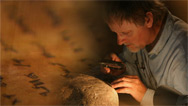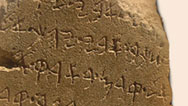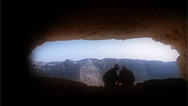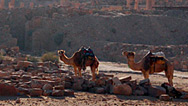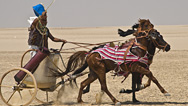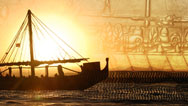
Secrets of Noah's Ark
A team attempts to build the flood boat using inscriptions from an ancient clay tablet. Airing December 21, 2016 at 9 pm on PBS Aired December 21, 2016 on PBS
- Originally aired 10.07.15
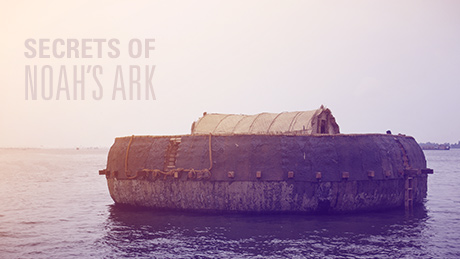
Program Description
Transcript
Secrets of Noah's Ark
PBS Airdate: October 7, 2015
NARRATOR: First came the rain, then the flood,…
MICHAEL COOGAN (Harvard Divinity School): When you're telling the story of the beginnings of humanity, the flood story is part of that story.
NARRATOR: …then, with the rising waters, a life-saving vessel. In the Book of Genesis, God commands Noah to build an Ark.
PETER MACHINIST (Harvard University): The Noah story serves to provide a platform of understanding for all future disasters. It is the ultimate disaster.
NARRATOR: But where does the story come from? An ancient tablet may hold the answer.
IRVING FINKEL (British Museum): I took one look at it, and to my astonishment, I realized that this was another retelling of the Flood Story.
NARRATOR: Far older than the Bible, the text describes a vessel very different from Noah's.
TOM VOSMER (Maritime Archaeologist): Everyone has their image of the Ark. And then, suddenly, we have this one appear that says, “Hey, it's round. It's a basket boat.” I think that's a fascinating thing to look at.
NARRATOR: Now, a team of investigators has set out to build the ark described in the tablet, traveling to the once lush marshlands of Iraq, near the site of ancient Babylon, a land that was ravaged by regular floods, and to India, where craftspeople, skilled in ancient techniques, will attempt to construct a vessel large enough to withstand a major flood.
TOM VOSMER: I think, if you brought a Babylonian into the present to see this boat when it's finished, that he would recognize it as something coming from his culture.
NARRATOR: The story of the Ark, a turning point in history, when the Babylonian empire collides with the world of the Bible.
PIOTR MICHALOWSKI (University of Michigan): This is the moment at which the history of the Jewish people begins, not at the beginning of time, after the flood.
NARRATOR: Climb on board to discover the Secrets of Noah's Ark, right now, on NOVA.
At the Israel Museum, in Jerusalem, some of the oldest known fragments of the Bible are being recorded and preserved. The 2,000-year old Dead Sea Scrolls contain the first Biblical reference to a cataclysmic flood.
ACTOR (Reading from the Book of Genesis): The Lord saw how great the wickedness of the human race had become on the earth. So the Lord said, “I will wipe from the face of the earth the human race I have created.”
But Noah found favor in the eyes of the Lord. Genesis 6:5, 7 and 8.
ON-SCREEN GRAPHIC OF TEXT FROM THE BIBLE BOOK OF GENESIS: AND THE FLOOD WAS FORTY DAYS UPON THE EARTH: AND THE WATERS INCREASED, AND BORE UP THE ARK, AND IT WAS LIFTED ABOVE THE EARTH.
NARRATOR: Today, the story of Noah and the Flood is central to the scriptures of Judaism, Christianity and Islam.
ON-SCREEN GRAPHIC OF TEXT FROM THE QUR'AN: PLACE ON BOARD THIS ARK A PAIR OF EACH SPECIES, AND YOUR FAMILY.
NARRATOR: In the story, God sends a great flood as punishment for the sins of humanity.
MICHAEL COOGAN: Because it is a moral, ethical god, the takeaway lesson is that you better do what this god wants, otherwise there will be big trouble.
NARRATOR: The righteous Noah is told by God to build an ark to save his family and a pair of every type of animal.
When the storm subsides, Noah offers a sacrifice to God, who then makes a covenant with Noah, promising that humanity will never again be destroyed by flood.
This pact between man and God is the foundation of morality in the Biblical Book of Genesis.
MICHAEL COOGAN: When you're telling the story of the beginnings of humanity, the flood story is part of that story.
DAVID VANDERHOOFT (Boston College): Without this moment of the flood, you have no framework within which humans can develop the life that will permit their perpetuity. You have to have it there.
NARRATOR: But why is a defining moral tale in the Bible, forged in the desert hills of Judea, shaped by a flood and a ship? Where did its authors get the idea?
The answer lies in the world's first writing system. At the British Museum, Dr. Irving Finkel is one of the world's few experts in the ancient script called cuneiform. And he shares his knowledge with all generations.
IRVING FINKEL: This is an exercise tablet from an ancient school. And it's made of clay, squashed flat, and the writing is done on the surface of the clay. So they never wrote on paper or papyrus like the Egyptians.
NARRATOR: Cuneiform evolved in what is today modern Iraq, in an ancient area between the Tigris and Euphrates Rivers: Mesopotamia, the cradle of civilization. The earliest examples are from around 5,000 years ago. Originally used for bookkeeping, its first marks are symbols of commodities, like these ears of barley.
But soon this picture-based system develops into symbols representing syllables.
IRVING FINKEL: Divide the name up into syllables. Henry is He-en-ry.
It was a tremendously significant step for the human race, because it meant suddenly it became possible to record language properly.
NARRATOR: Over the course of two millennia, cuneiform tablets become widespread throughout Mesopotamia. It's here, during the 19th century, that British archaeologists uncovered 130,000 of them, now under Irving's care.
One of them told an explosive story. In 1872, its secret was revealed by a British museum assistant named George Smith.
IRVING FINKEL: George Smith is a bit of a hero of mine. He turned out to have an absolute genius for understanding cuneiform almost at sight. When Smith read the story in this tablet, he read something that no person had read since remote antiquity.
NARRATOR: In the tablet, from 700 B.C.E., Smith was shocked to read key parts of a flood story that closely resembled Noah.
ON-SCREEN GRAPHIC OF TEXT FROM THE ARK TABLET: “BLOWING WIND, STORM, DELUGE.”
IRVING FINKEL: He discovered there was going to be a deluge to destroy the world, that the gods choose one human being as a hero, and this character had to build a boat, in order to put life in it, to withstand the waters, so that after it, everything could start all over again.
I think he had a proper fit, because of the shock of discovering a text, which he knew from the Hebrew Bible by heart, was suddenly there, in front of him, in this totally strange medium.
NARRATOR: Smith found parallels in even the most obscure details. In both stories, the flood hero releases three sets of birds to find dry land. And both offer a sacrifice that their god smells.
IRVING FINKEL: The two texts were somehow strongly wedded together. They had a literary relationship. One derived from the other.
NARRATOR: Over 1,000 years, several versions of the Babylonian flood myth emerged. Could the parallels between all these Mesopotamian flood myths and Noah's story be merely coincidence?
PIOTR MICHALOWSKI: There's a borrowing here. They're all different pictures of the same personage, the same literary creation.
ON-SCREEN GRAPHIC OF TEXT FROM THE ARK TABLET: “BLOWING WIND, STORM, DELUGE”
PETER MACHINIST: There's an overall parallel. There are a number of very specific points of parallel, which suggest that this is not just a random association.
NARRATOR: But there is one major difference: the ark itself. In the Hebrew Bible, Noah builds a massive rectangular boat, but in one of the earliest Babylonian stories the ark description is incomplete.
IRVING FINKEL: It says, “The ark you are to build, dot, dot, dot,” “be equal dot, dot, dot,” and then it's broken.
NARRATOR: Because the tablet is missing a piece, features of the Babylonian Ark were a mystery.
It would be almost a century before a key clue would emerge. In 1948, a Royal Air Force officer named Leonard Simmonds was serving in the Middle East. One day, he went into a market and bought an interesting looking piece of clay with strange inscriptions. The object lay forgotten in his home for 40 years, until his son took it to the British Museum to see if it might be of interest.
IRVING FINKEL: Once in a while manna from heaven falls just when you need it.
NARRATOR: The tablet was from the ancient Mesopotamian kingdom of Babylonia.
IRVING FINKEL: This is what the tablet looks like. Nothing exceptional, until you start to read it. I took one look at it, and I realized, to my astonishment, that it was another re-telling of the flood story.
NARRATOR: But the inscription was squeezed onto a 4,000-year-old, badly damaged piece of clay.
To confirm his first analysis, Irving takes the tablet to the International Manufacturing Centre at Warwick University. They produce a perfect 3D model, allowing him to reexamine the text in forensic detail.
The tablet begins with a Babylonian god's instructions to the hero of the story, named Atra Hasis.
IRVING FINKEL: He tells him to tear down your house, and use the materials to build a boat.
NARRATOR: And then comes a detailed description of this boat.
IRVING FINKEL: “Eighshesema,” draw it out. “Eserti kepatim,” with the design of a circle.
ON-SCREEN GRAPHIC SHOWING WORDS FROM BABYLONIAN TABLET: ETSERTI KIPPATIM / DESIGN OF A CIRCLE
As you wade through this funny script, you cannot deny that this was the idea. It was a round boat.
You think to yourself that, “How can this be?” The Ark is one of the most familiar, iconic things in the whole world. But when you think about it, we know that on the rivers of Mesopotamia, the Euphrates and the Tigris River, they had round boats.
NARRATOR: On a Mesopotamian seal, dated 2500 B.C.E., is the cross-section of a round vessel. And at the British Museum are other images of round boats, called coracles, from 700 B.C.E. carrying cargos of stone. So is the tablet describing a real vessel?
IRVING FINKEL: It's supposed to be mythology, but as you go further down the tablet, you discover that the detailed specifications about how to build this thing are given us.
ON-SCREEN GRAPHIC OF TEXT FROM BABYLONIAN TABLET: LET HER LENGTH AND BREADTH BE EQUAL / ROPES / LET HER FLOOR AREA BE ONE FIELD / BITUMEN / LET HER SIDES BE ON NINDAN HIGH / RIBS
NARRATOR: The tablet lists the ark's components and proportions in detail, suggesting real boat-building knowledge.
IRVING FINKEL: Instead of it being made up facts, we actually have details predicated on the idea of building a real coracle.
NARRATOR: But the coracle described in the tablet is enormous, 222 feet across. So Irving wanted to know, could such an enormous round boat actually be built?
IRVING FINKEL: Quite frankly, it seems to me, the only possible thing you could do was to take these instructions about how to build a giant coracle and build a giant coracle.
NARRATOR: Very few boat builders in the world have the expertise to take up Irving's challenge, but if there's one person who can build such a vessel, it's maritime archaeologist Dr. Tom Vosmer. Tom has built a career from resurrecting ancient boats from literary evidence.
TOM VOSMER: Everyone has their image of the Ark, and then suddenly we have this one appear that says, “Hey, it's round. It's a basket boat.” I think that's a fascinating thing to look at. Let's see if we can make it work.
NARRATOR: With him is Eric Staples, maritime historian and boat builder, and Alessandro Ghidoni, a world expert in ancient boat technology.
They've taken Irving's translation of the tablet and converted the Babylonian measurements. Right away, they see the problem: the scale of the ark is so big, its structure could never support its weight.
TOM VOSMER: Its size, it's obviously physically impossible, but let's try to see how far we can push it, how large we can actually make it.
NARRATOR: Also, the tablet lists materials, but doesn't say how the Babylonians would have put them together.
Luckily, there is more recent evidence. These images, from the 1930s, show round Iraqi boats, called quffas, ferrying passengers and goods. In 1934, a British boat historian, named James Hornell, carried out detailed research on quffas. He wrote that they were made of fibrous plants found near waterways, either reeds or palm leaves, bound into ropes and coiled into a basket-like hull. Wooden ribs held the shape of the hull, and a layer of bitumen, or pitch, made it waterproof.
ON-SCREEN GRAPHIC OF TEXT FROM BABYLONIAN TABLET: KA-AN-NU SE-RI ITTU / ROPES RIBS BITUMEN
NARRATOR: These are the same materials described in the 4,000-year-old Ark tablet that Irving Finkle analyzed.
If the team is going to build the kind of round boat described in the Babylonian myth, they need to examine a more modern example. These are the heavily guarded oilfields of southern Iraq. For any outsider, traveling here is risky.
ERIC STAPLES (Maritime Historian): Coming into what's described as an unsecure environment, in order to flesh out the details of how to build a Babylonian ark, is definitely a new one for me. That's for sure.
NARRATOR: Eric needs to reach one of the few places where there is evidence of Iraq's traditional boat-building skills, the great marshes of southern Iraq. This ancient aquatic wilderness once covered 12,000 square miles. It was home to hundreds of thousands of Marsh Arabs. But much of it was drained by Saddam Hussein, in the early '90s, to punish those resisting his regime.
Eric has come to meet Azzam Alwash. Azzam is an expert in marsh traditions and boat technology, and he also owns possibly the last remaining quffa in Iraq.
As modern roads, bridges and river launches were built, quffas became obsolete. This example only exists because Azzam had it constructed.
AZZAM ALWASH (Nature Iraq): So here's our quffa.
ERIC STAPLES: This is the quffa? Wonderful.
AZZAM ALWASH: The building of this quffa started with weaving in circles. It's rings upon rings upon rings, woven together with traditional weaving techniques. The same techniques…
NARRATOR: Eric recognizes the components described in the Ark tablet: the coiled rope of the hull, made from marsh reeds; the wooden ribs of its skeleton; and waterproofing bitumen, the asphalt-like substance that's been used to seal the hulls of boats since antiquity.
ERIC STAPLES: Do you think I could give it a try?
AZZAM ALWASH: Sure. Why not? Hey. Nice little sailor.
NARRATOR: It's very stable, which is why it was once used as an all-purpose ferry-boat. But Eric wants to know if it can be scaled up? And if so, how big can he build a round boat?
The 20th century historic record indicates that the biggest quffas were up to 18 feet in diameter, much less than the 222 feet the tablet suggests. Could this be the limit of the round boat technology, today and in ancient times?
Azzam takes Eric to see a building technique that dates back more than 5,000 years, a reed house.
AZZAM ALWASH: So, there it is. The entire rigidity of this structure comes from the tension built into these arches. There is no metal in the building of these structures. It's reeds upon reeds upon reeds. They are brought together by the tension of these twisted reeds.
NARRATOR: Could the ancient Babylonians have used this house-building technique as the basis for constructing their large round ark?
ERIC STAPLES: The circle that runs around here is one way of basically holding it all in together, using the natural tension, the strength of reeds, because they are flexible, but there is still strength in the flexibility, particularly when you bundle them like this.
AZZAM ALWASH: But you're saying, here, that this is going to be 10, 15 meters?
ERIC STAPLES: Ten, 12 meters yes, yes.
AZZAM ALWASH: Okay.
NARRATOR: Eric arrived with just the 4,000-year-old tablet details. Now he has the beginnings of a design for his large Babylonian coracle, but many obstacles remain, beginning with where to build.
ERIC STAPLES: I'd love to build it in Iraq, but considering the logistical issues and the security issues, as well, it's not realistic here. So the question is where, if not Iraq?
NARRATOR: Another question is how credible the tablet is in describing the flood. Today, this region is desert. How likely is it that a great flood could have inundated this parched landscape thousands of years ago, as the Babylonian myth describes?
This is one of the places that gave birth to that legend. Home of first the Sumerian, then Babylonian empires: the ancient city of Ur, just 20 miles from the great marshes. Ur dates back more than 5,000 years. It's here, in 1928, that British Archaeologist Sir Charles Leonard Woolley made a startling discovery.
In 1922, Woolley and his team came in search of early Mesopotamian civilization. He found remains of an entire Royal dynasty. A testament to the sophistication and power of the Sumerian elite.
And then, he made an equally stunning discovery: a distinctive layer of river silt, 10-feet-thick. It had been laid down by a massive flood. The grandson of a member of Woolley's team relates how the discovery evoked the Biblical story of Noah.
DHEIF MUSHIN (Site Supervisor, Ur): They found layer of sand to the south of Ur, north of Ur and east and west. And that happen a big flood. And they thought the same, the flood of Noah, the great man, the great prophet at that time.
NARRATOR: This connection to Noah's flood made the layer of sand more famous than Ur's treasures, especially when other archaeologists began finding flood deposits in neighboring cities like Uruk, Shuruppak and Kish.
ON-SCREEN GRAPHIC: KISH / URUK / SHURAPPAK / UR
NARRATOR: The idea of a single great flood grew, but there was a problem. When the layers were dated, they were found to be caused by different events, spread over a thousand years.
ON-SCREEN GRAPHIC: KISH 2,500 BC / URUK 2,900BC / SHURAPPAK 2,700BC / UR 3,500BC
So was there ever really a single great flood? Landscape archaeologist Dr. Jenny Pournelle is looking for the answer.
For over a decade, Jenny has been investigating how the landscape of Iraq has changed over thousands of years. Today, she is taking a core sample, part of a series that covers a broad area. She's digging 68 miles south of Ur, in a marshland that was recently drained for oil exploitation.
It's a chance for her to get a piece of uncontaminated earth, essential for accurate dating.
JENNIFER POURNELLE (University of South Carolina): You can see this light, light grey silt. And these little guys are very typical of freshwater marshes around here. It means that our core will have been protected by this marsh cover, until recently, when it was drained.
NARRATOR: This core will help reveal if ancient Mesopotamia was impacted by a cataclysmic flood.
JENNY POURNELLE: This should be something like year zero. And that may be 1000 B.C., and if we're lucky, right about here is when your Ark tablet was written.
NARRATOR: So what does this sample show?
They open it to see.
JENNY POURNELLE: We've got layers, quite clear ones. See that nice orange sediment? It would suggest that there was a river that periodically flooded and deposited sediment.
NARRATOR: Evidence from cores like this indicates that in ancient times, Mesopotamia was crisscrossed by rivers and canals that flooded constantly.
JENNY POURNELLE: Every year, there are two floods, one in the spring, one in the fall.
As cities first grew, floods were part of, not just a natural cycle, but an essential cycle. They were profoundly dependent on the marshes and all of the wealth of products that came out of them: food for themselves, food for their livestock, trade, commerce.
NARRATOR: Ur was one of many cities that arose in this water world. The Euphrates River was its life source. It delivered fertile soil, fish and wildfowl, but it could also bring disaster.
JENNY POURNELLE: The Tigris, the Euphrates also had super floods every 10 years, every 100 years, every 1,000 years.
When we have the first recorded stories of the flood myth, the cities where these were being written down are exactly in that precarious position.
They created around them fragile environments. With the right amount of water, they can be incredibly productive and incredibly wealthy, but with the wrong amount of water, the very irrigation works they need to produce that wealth are blown away.
Everyone has a vested interest in this flood story. Everyone knows that it makes or breaks their careers, their livelihoods. That would be the power of the flood myth in this part of the world.
NARRATOR: So it wasn't a single great flood that inspired the myths, but centuries of periodic flooding. And would a large round boat have helped these ancient people to survive these floods?
The boat-building team is trying to figure out if it could even have been built at all. They found a place to build their Babylonian coracle in Southern India, where they can access the materials listed in the tablet, and the skills to put them together.
Construction begins on the shore of Lake Vembanad. The fibrous plants they will use for the hull will be reeds from a nearby marsh. Some of the 16.5 tons of wood they will need arrives at the boatyard.
They've settled on the size of their ark, about 40 feet in diameter, just a fifth the size of the ark described in the tablet. But at 40 feet, it will weigh 35 tons, right at the limit of what they believe the materials and the ancient techniques will stand.
Once the ark is in the water, the bottom will flex, straining the frame, possibly causing it to break. The bigger the ark, the bigger the pressure.
TOM VOSMER: The largest quffas that I'm aware of may be six meters. This, we're pushing beyond that. It's actually eight times as big as the six-meter one. So we're increasing the forces we have to contend with, exponentially.
NARRATOR: To hold the frame together, they will reinforce it, combining basic engineering with known Babylonian carpentry techniques. The Ark tablet states that the flood vessel has 30 ribs. They lock these ribs in a latticework. Tensioned bands will hold the tops of the ribs together. The deck layer will add further rigidity. And a forest of stanchions will prevent the bottom from collapsing upwards.
TOM VOSMER: Maybe it's all going to fall apart. Who knows? But maybe it will succeed, and we'll think, “Ah, we could have pushed it a little bit more!”
NARRATOR: The ark will contain more than 800 pieces of wood, in 6,000 individual connections, cut and shaped using traditional tools. There will be no metal, modern sealant or adhesive. As instructed by the tablet, the team also begins to bind reeds into tightly packed lengths of rope. They'll need a mile and a half to cover the entire hull.
ERIC STAPLES: You have this little coil that spirals out. The idea is that you gradually create a gigantic basket, basically made of grass.
NARRATOR: As the beginning of the reed coil is lashed into place, they turn their attention to the next major challenge: waterproofing. The tablet calls for natural bitumen, which doesn't exist in India but is found, oozing out of the ground, in Iraq.
Natural bitumen has unique impurities, which make it adhesive and resistant to heat. Alessandro, the team's expert in ancient boat technology, needs to re-create these properties, starting with refined, industrial bitumen. He adds animal fat and fish oil to make it sticky, and lime powder made from burnt lake shells, to give it heat tolerance. Getting the balance of these ingredients right is critical.
ALESSANDRO GHIDONI (Maritime Archaeologist): If you put too much lime powder, it will get very hard, it will resist at high temperature, but it won't stick. If you put too much fish oil or animal fat it will, it will stick easily, but it will melt under the sun, basically.
NARRATOR: Alessandro's cooking skills will determine whether the ark will float or not.
ALESSANDRO GHIDONI: Like this.
NARRATOR: They've given themselves six months to build, the recorded gap between seasonal floods in ancient Mesopotamia. Then, they'll face the greatest challenge of all: getting the ark into the lake. A boat usually has a keel that can support it as it slides into the water. A round boat has no keel. And this one will be covered in a fragile layer of bitumen.
ALESSANDRO GHIDONI: You cannot drag the boat on the ground, you cannot pull it. The bitumen layer is extremely delicate. It's very soft. And you don't want it damaged, because it's the only, basically, layer that keeps your boat waterproof. Without the bitumen, the boat won't float.
NARRATOR: How would the Babylonians have launched the boat? The Ark tablet doesn't say. The hero, Atra Hasis simply waits for the flood.
ERIC STAPLES: It is one of these big questions, sort of a burning question, you know, if a boat this large could actually have been built. Unless there was a flood, it would have been incredibly difficult to launch.
NARRATOR: A vessel like this could have meant survival in a world of constant flooding. But at some point, those floods become mythologized into a single great deluge, and real coracles are turned into a single giant ark of legend. And somehow, that legend of the round ark becomes the familiar boat shape in the story of Noah.
How does such a transition occur? The answer lies in a great innovation of the ancient world: cuneiform writing.
IRVING FINKEL: Originally, all these stories circulated orally. Around 2000 B.C., we see, for the first time, that these narratives became reduced to writing. And from that moment, they are fixed rigidly, so, you have an established text, which all the scribes copy.
NARRATOR: And in the process of copying, errors creep in. Irving Finkel believes one of these errors changes the shape of the ark. The Ark tablet, dated around 1750 B.C.E., 4,000 years old, places the round ark inside a square to help define its dimensions.
ON-SCREEN GRAPHIC OF TEXT FROM BOTH TABLETS: ATRAHASIS / GILGAMESH
NARRATOR: By 700 B.C.E., the Atra Hasis flood tale has been absorbed into a more famous story, the exploits of a hero king in The Epic of Gilgamesh. But here, scribes omit the mention of the circle.
IRVING FINKEL: We have these later scribes who have an old text. They look at it, and they decide, “Well, all this technical stuff, we don't need it.” And they don't read the thing very carefully, at all, because in the description about how round it was, they miss the point.
NARRATOR: As a result, according to Irving, the Gilgamesh ark has a very strange shape.
IRVING FINKEL: Like a kind of sky scraper. What would happen if that were put in the water? It would sink, wouldn't it? Especially if it was full of animals. It's absolutely hopeless!
NARRATOR: Over time, the mythical ark loses touch with the reality that likely inspired it. It sets off on a literary journey, changing with new interpretations.
IRVING FINKEL: There is a rather ironic consequence. You have the possibility of an error being consolidated, copied and recopied, until nobody thinks about it anymore and just take it for granted. And that is surely what happened with the shape of the ark.
NARRATOR: It eventually adopts the boat shape we know in the story of Noah, and the rest of the story changes, too. Almost 2,000 years after the first Babylonian version, the flood story is found outside Mesopotamia, in the Hebrew Bible.
PIOTR MICHALOWSKI: There's just no way of explaining the story in Genesis, except as a borrowing. The question is when, how and why?
NARRATOR: It's long been assumed that trade and cultural exchange bring the Babylonian story to ancient Israel, but this doesn't explain why Biblical writers adopt the tale, and give it a moral twist.
In the Mesopotamian myth, pagan gods are disturbed by human noise and use the flood to reduce their numbers, but in the Book of Genesis, the flood is a disaster that God uses to punish people for their sins.
PETER MACHINIST: The Noah story serves to provide a platform of understanding for all disasters. It is the ultimate disaster.
MICHAEL COOGAN: It was not just natural disasters that were attributed to God, it was also historical disasters.
NARRATOR: The history of the people to be known as Jews is filled with disasters that are reflected in the Bible. But many experts believe there is one, in particular, which provides an explanation for the story of Noah: the Babylonian destruction of Jerusalem in 587 B.C.E., a consequence of the Judean kingdom's failure to pay tribute.
DAVID ILAN (Hebrew Union College): If somebody is not paying their taxes, not paying tribute as they're supposed to, you have to make an example of them, so you need to come in and show what your powers are capable of enforcing.
NARRATOR: Several thousand Judeans, the educated and the powerful of ancient Israel, were marched, about 1,000 miles, to Babylon.
DAVID ILAN: The Babylonians needed manpower. They had fields that needed to be cultivated and craftsmen that needed to be imported, to make their tremendous buildings and other things that they did. So, you imported manpower to do those kinds of things.
I think, for a lot of people, there probably was a sense that this is the end of the world as we know it.
ACTOR (READING FROM THE BOOK OF PSALM): Our tormentors demanded songs of joy; they said, “Sing us one of the songs of Zion!”
But how can we sing the songs of the Lord while in a foreign land?
Psalm 137: 3 and 4.
NARRATOR: Yet, this traumatic uprooting brought the Judeans into direct contact with Babylonian culture, and that would shape the destiny of their scripture and the story of Noah.
One of the greatest collections of Babylonian relics in the world is found here, at the Pergamon Museum, in Berlin. It includes a reconstruction of the entrance to Babylon. The newly arrived Judeans would have walked through this gate. On the other side was a world they could scarcely have imagined.
In the 6th century B.C.E., Babylon was the most cosmopolitan city on Earth. But what was the Judean experience? Dr. Cornelia Wunsch is an Expert in Neo-Babylonian culture. She has evidence suggesting exile in Babylon wasn't as bad as the Judeans might have feared.
CORNELIA WUNSCH (SOAS, University of London): They have been allotted land, and they are tilling the land and building houses, and they are doing reasonably well there.
DAVID ILAN: It may have been awful at the beginning, and nobody wanted to be in exile, but, very quickly, things got good. Judea made it after one or two generations. They were well-ensconced into the Babylonian economies. They did well.
NARRATOR: A Babylonian-style personal seal of a Judean merchant named Arricam suggests how assimilated some Judeans were in this new society.
CORNELIA WUNSCH: He certainly led a dual existence. Arricam is clearly showing himself as a person of Judean descent, but on the other hand a typical Babylonian businessman.
NARRATOR: Many Judeans in Babylon were well-integrated into Babylonian culture, but they also preserved their own traditions. This was the case for Judean scribes, who were editing traditional stories and prayers and writing new ones that would ultimately become the Hebrew Bible.
MICHAEL COOGAN: These priestly authors, who were writing in Babylon, obviously had the exile on their minds. And one of the most significant aspects of this event was the formation of the Bible. It began in Babylon.
PETER MACHINIST: Some of these books were already in process but seem to have been shaped by the experience of the exile.
NARRATOR: In the center of Babylon is a giant ziggurat. In the Book of Genesis, it becomes the ultimate symbol of human folly, the Tower of Babel.
For Irving Finkel, this borrowing is just one of many. In collaboration with the Archaeological Institute, in Berlin, he examines extraordinary evidence that links some elements of Babylonian literature with the beginnings of the Hebrew Bible.
One is the story of King Sargon, who was cast adrift by his mother, in a round basket, to save him from being discovered.
IRVING FINKEL: She made a little ark out of reeds and bitumen, and she put the baby in the ark, and she put the ark in the river, and away it went. Now, this is a story that has a certain familiar ring about it, from the Book of Exodus point of view, because Moses was given the same kind of origin.
NARRATOR: There's also a list of Babylonian kings before the flood, very similar to Adam's genealogy described in the Book of Genesis. But the most amazing piece of evidence is written on a Babylonian school tablet, a re-telling of Gilgamesh, the epic poem that contains the flood story.
IRVING FINKEL: What does it tell us? It tells us that you have, at this time, at Babylonia, schoolrooms where the Gilgamesh story, undoubtedly including the flood story, was on the curriculum.
NARRATOR: Could Judean children have read these same stories? A detail in the Bible's Book of Daniel, suggests they did. According to the story, Daniel was the son of an exiled Judean nobleman. In Babylon, the Bible says, he and his friends were taught to read cuneiform. Just as these children discover, learning cuneiform isn't hard. It would have made Babylonian stories easy to absorb.
IRVING FINKEL: These kids suddenly find themselves learning these very narratives, which seem to us the essential Babylonian narratives, that ended up embedded in Judean Hebrew.
PIOTR MICHALOWSKI: The idea that it was Judeans in Babylonian captivity, who learned cuneiform and adopted the flood story is, to me, the only decent explanation that you can have.
NARRATOR: If this theory is correct, stories like Noah and the flood were widespread in Babylonian culture and absorbed into Judean scripture. They would eventually become the moral teaching for three great faiths, but not until the Judeans emerge from exile.
In India, the Babylonian ark is almost complete. And unlike the Babylonians, who would have just waited for floodwaters to rise, the building team has had to find a way to launch the ark without dragging its fragile hull across the ground.
ERIC STAPLES: We have two rails running straight underneath the ark into the water. So, on top of these rails, we're going to put rollers. And then on top of the rollers, another set of runners. And then, sitting on top of these runners, we have the launch platform. And then, on top of the platform is the ark. Once she's all ready to go, basically, just roll it into the lake.
NARRATOR: It's a traditional boat launching technique, but they've had to resort to modern machinery to build the launch platform. Once in the water, the platform will sink, leaving the coracle to float away. Except, as things stand, it probably won't. Alessandro's version of Babylonian bitumen is melting and dropping off.
ALESSANDRO GHIDONI: It's really quite catastrophic, at this stage. Once we launch the boat, the water can push through the gaps and holes, and then we're going to have major leak.
NARRATOR: Just before launch, the ark is still not waterproof.
In 539 B.C.E., after over 50 years in exile, the Judeans were allowed to return home. They began rebuilding the Israel of old, with a new temple and a single text: the Torah.
MICHAEL COOGAN: One of the most remarkable things about ancient Israelite religion is that it survives. The Babylonians conquered Jerusalem, but the exiles from Jerusalem did not give up belief in their God.
NARRATOR: The Babylonian flood myth is now retold as a moral lesson. In some ways, it's a metaphor for the exile.
DAVID VANDERHOOFT: The foreign agent comes; punishes, as a tool of God's wrath; there's a cataclysm to be survived by a select few.
NARRATOR: And for them, the promise of a new beginning is echoed in the Noah story.
ACTOR (READING FROM THE BOOK OF GENESIS): God blessed Noah and his sons, saying to them, “Be fruitful and increase in number and fill the earth.”
I establish my covenant with you.
Never again will all life be destroyed by the waters of a flood.
Genesis 9: 1, 11.
NARRATOR: This covenant defines man's relationship with God and marks the birth of Judaism.
MICHAEL COOGAN: The great Israeli scholar Yehezkel Kaufmann said: “The exile is the watershed. With the exile, the religion of Israel comes to an end and Judaism begins.”
PIOTR MICHALOWSKI: This is the moment at which the history of the Jewish people begins, not at the beginning of time, but after the flood.
NARRATOR: In India, Irving's theory that the legend was based on an authentic boat-building tradition is about to be put to the test. The big question is Alessandro's bitumen recipe. Will it work?
For Irving, the culmination of years of translation, study and investigation is this moment.
IRVING FINKEL: I can hardly believe my eyes, After all this imagination, it's really in the flesh, so to speak. It's incredible. It's incredible.
NARRATOR: The ark is raised on inflatable rollers, on its launch platform. It begins its journey down to the lake. Alessandro is standing by to plug any leaks from the outside, but before he can, a roller slips free, pitching the ark in the water. Below decks, it's clear their non-Babylonian waterproof mix isn't working.
ERIC STAPLES: So we are now floating, which is the good news. The potentially bad news, however, is that we have a heck of a lot of water coming in at the moment.
NARRATOR: They had hoped to get animals on board. But right now they're consumed with saving the ark. They plug the gaps and put a collection of pumps to work. By the time Irving climbs on board, the problem is under control.
ERIC STAPLES: Welcome aboard.
IRVING FINKEL: Thank you. I'm glad to be here. How wonderful. How absolutely wonderful!
NARRATOR: The boat-building team never managed to duplicate Babylonian bitumen, but the structure of the ark is sound.
At the root of the story may have been a flood vessel like this one. Behind the legend of a great flood were thousands of real floods. And behind the myth of a giant ark is a genuine tradition of round boat building. All this, from a Babylonian tablet, a story that emerged 4,000 years ago. It continues to resonate today, as one of the world's most enduring tales.
Broadcast Credits
Laura Warner
Elizabeth Trojian
Michael Wadding
David Smillie
McDonald Brown
Redlab Digital
Eric Staples
AP Archive
Bridgeman Images
Danish Film Institute - Filmarchive
Footage Farm Ltd
Getty Images
The Jewish Museum / Art Resource/ Scala, Florence
Library of Congress
Oriental Institute, University of Chicago
Pond 5
Shutterstock, Inc.
Trustee British Museum
University of Cambridge Museum of Archaeology and Anthropology
University of Pennsylvania Archives
University South Carolina, Moving Image Research Collection
The Museum of Ancient Near East, Berlin
Bible Lands Museum Jerusalem
The University of Warwick
The British Museum
Elliott Halpern
Elizabeth Trojian
John Luker
Musikvergnuegen, Inc.
Rob Morsberger
Eddie Ward
Caitlin Rotman
Produced by Blink Films and Yap Films for NOVA/WGBH Boston in association with Shaw Media, France Television, Channel 4, NGCI, TV3, and ORF. A Canada - UK Co-Production.
© 2014 Blink Entertainment Limited/Yap Ark Productions Inc.
All Rights Reserved
Additional Material © 2015 WGBH Educational Foundation
This program was produced by WGBH, which is solely responsible for its content.
Original funding for this program was provided by Google, Cancer Treatment Centers of America, the David H. Koch Fund for Science, and the Corporation for Public Broadcasting.
- Image credit: (ark replica)
- © WGBH Educational Foundation
IMAGE:
Participants
- Azzam Alwash
- Founder, Nature Iraq
- Michael Coogan
- Harvard Divinity School
- Irving Finkel
- British Museum
- Alessandro Ghidoni
- Maritime Archaeologist
- David Ilan
- Hebrew Union College
- Peter Machinist
- Harvard University
- Piotr Michalowski
- University of Michigan
- Dheif Mushin
- Site Supervisor, Ur
- Jennifer Pournelle
- University of South Carolina
- Eric Staples
- Maritime Historian
- David Vanderhooft
- Boston College
- Tom Vosmer
- Maritime Archeologist
- Cornelia Wunsch
- SOAS, University of London
Preview | 00:30
Full Program | 53:09
Full program available for streaming through
Watch Online
Full program available
Soon

